Improving Life Cycle Sustainability and Profitability of Buildings through Optimization: A Case Study
Abstract
:1. Background
2. Literature Study and Research Objective
2.1. Life Cycle Sustainability
2.2. Multi-Objective Optimization
2.3. Research Objective and Scope
3. Method
3.1. Multi-Objective Optimization
3.1.1. Design Variables
- Material types were used to find the optimal insulation materials in the building’s envelope (e.g., type of insulation in the slab) and were defined in discrete form.
- Material quantities were used to find the optimal quantities of insulation materials in the building’s envelope (e.g., thickness of insulation in the slab) and were defined in continuous form.
- Window types were used to find the optimal type of windows and were defined in discrete form.
3.1.2. Create Building Model
3.1.3. Input Data Computation
- Dynamic energy simulation was set up using EnergyPlus to simulate the annual energy performance and the operative temperature in different zones.
- Quantity take-off was set up using a Python script that calculated the quantities of each construction element using their surface area and constituent material quantities (i.e., thicknesses).
- Floor area calculation was set up using a Python script where the building’s floor area could be calculated based on changes in the thicknesses of the exterior walls and insulations. This was achieved by offsetting the edges of a polygon representing the outline of the building according to the changes in exterior wall thicknesses, followed by calculating the enclosed area of the polygon.
3.1.4. Constraints
- Annual primary energy number was used to ensure that the solutions satisfy the building’s maximum allowed annual primary energy number (85 kWh/m2 heated floor area for multi-family residential buildings). Note that this value is different from the operational energy use and is calculated based on the guidelines of the Swedish building code.
- Heat transfer coefficient was used to ensure that the solutions satisfy the maximum allowed overall heat transfer coefficient (Um = 0.4 W/m2K).
- Operative temperature was used to ensure that the solutions obtain at least the minimum occupied zone operative temperature (18 °C).
3.1.5. Perform Trade-Off Optimization
3.1.6. Select Optimal Solution(s)
3.2. Description of the Case Study Building
3.3. Genetic Algorithm Parameters
4. Results
4.1. Results and Analysis
4.2. Validation
5. Discussion and Conclusions
6. Limitation and Future Research
Author Contributions
Funding
Data Availability Statement
Acknowledgments
Conflicts of Interest
References
- Alam, M.; Singh, H.; Suresh, S.; Redpath, D.A.G. Energy and economic analysis of Vacuum Insulation Panels (VIPs) used in non-domestic buildings. Appl. Energy 2017, 188, 1–8. [Google Scholar] [CrossRef] [Green Version]
- Fantucci, S.; Garbaccio, S.; Lorenzati, A.; Perino, M. Thermo-economic analysis of building energy retrofits using VIP-Vacuum Insulation Panels. Energy Build. 2019, 196, 269–279. [Google Scholar] [CrossRef]
- Zalejska-Jonsson, A.; Lind, H.; Hintze, S. Energy-Efficient Technologies and the Building’s Saleable Floor Area: Bust or Boost for Highly-Efficient Green Construction? Buildings 2013, 3, 570–587. [Google Scholar] [CrossRef] [Green Version]
- Gil-Baez, M.; Padura, Á.B.; Huelva, M.M. Passive actions in the building envelope to enhance sustainability of schools in a Mediterranean climate. Energy 2019, 167, 144–158. [Google Scholar] [CrossRef]
- EU Directive. Directive (EU) 2018/844 of the European Parliament and of the Council of 30 May 2018 Amending Directive 2010/31/EU on the Energy Performance of Buildings and Directive 2012/27/EU on Energy Efficiency. 2018. Available online: https://www.legislation.gov.uk/eudr/2018/844 (accessed on 23 March 2022).
- Friess, W.A.; Rakhshan, K. A review of passive envelope measures for improved building energy efficiency in the UAE. Renew. Sustain. Energy Rev. 2017, 72, 485–496. [Google Scholar] [CrossRef]
- Rivera, M.L.; MacLean, H.L.; McCabe, B. Implications of passive energy efficiency measures on life cycle greenhouse gas emissions of high-rise residential building envelopes. Energy Build. 2021, 249, 111202. [Google Scholar] [CrossRef]
- Shadram, F.; Mukkavaara, J. Exploring the effects of several energy efficiency measures on the embodied/operational energy trade-off: A case study of swedish residential buildings. Energy Build. 2019, 183, 283–296. [Google Scholar] [CrossRef]
- Audenaert, A.; De Cleyn, S.H.; Vankerckhove, B. Economic analysis of passive houses and low-energy houses compared with standard houses. Energy Policy 2008, 36, 47–55. [Google Scholar] [CrossRef]
- Chastas, P.; Theodosiou, T.; Bikas, D. Embodied energy in residential buildings-towards the nearly zero energy building: A literature review. Build. Environ. 2016, 105, 267–282. [Google Scholar] [CrossRef]
- Schwartz, Y.; Raslan, R.; Mumovic, D. The life cycle carbon footprint of refurbished and new buildings—A systematic review of case studies. Renew. Sustain. Energy Rev. 2018, 81, 231–241. [Google Scholar] [CrossRef] [Green Version]
- Shadram, F.; Bhattacharjee, S.; Lidelöw, S.; Mukkavaara, J.; Olofsson, T. Exploring the trade-off in life cycle energy of building retrofit through optimization. Appl. Energy 2020, 269, 115083. [Google Scholar] [CrossRef]
- Sharif, S.A.; Hammad, A. Simulation-Based Multi-Objective Optimization of institutional building renovation considering energy consumption, Life-Cycle Cost and Life-Cycle Assessment. J. Build Eng. 2019, 21, 429–445. [Google Scholar] [CrossRef]
- Soares, N.; Bastos, J.; Pereira, L.D.; Soares, A.; Amaral, A.R.; Asadi, E.; Rodrigues, E.; Lamas, F.; Monteiro, H.; Lopes, M.; et al. A review on current advances in the energy and environmental performance of buildings towards a more sustainable built environment. Renew. Sustain. Energy Rev. 2017, 77, 845–860. [Google Scholar] [CrossRef]
- Tuhus-Dubrow, D.; Krarti, M. Genetic-algorithm based approach to optimize building envelope design for residential buildings. Build. Environ. 2010, 45, 1574–1581. [Google Scholar] [CrossRef]
- Amini Toosi, H.; Lavagna, M.; Leonforte, F.; Del Pero, C.; Aste, N. Life Cycle Sustainability Assessment in Building Energy Retrofitting; A Review. Sustain. Cities Soc. 2020, 60, 102248. [Google Scholar] [CrossRef]
- Shadram, F.; Mukkavaara, J. An integrated BIM-based framework for the optimization of the trade-off between embodied and operational energy. Energy Build. 2018, 158, 1189–1205. [Google Scholar] [CrossRef]
- Longo, S.; Montana, F.; Riva Sanseverino, E. A review on optimization and cost-optimal methodologies in low-energy buildings design and environmental considerations. Sustain. Cities Soc. 2019, 45, 87–104. [Google Scholar] [CrossRef]
- Machairas, V.; Tsangrassoulis, A.; Axarli, K. Algorithms for optimization of building design: A review. Renew. Sustain. Energy Rev. 2014, 31, 101–112. [Google Scholar] [CrossRef]
- Nguyen, A.-T.; Reiter, S.; Rigo, P. A review on simulation-based optimization methods applied to building performance analysis. Appl. Energy. 2014, 113, 1043–1058. [Google Scholar] [CrossRef]
- Wang, W.; Zmeureanu, R.; Rivard, H. Applying multi-objective genetic algorithms in green building design optimization. Build. Environ. 2005, 40, 1512–1525. [Google Scholar] [CrossRef]
- Wang, W.; Rivard, H.; Zmeureanu, R. Floor shape optimization for green building design. Adv. Eng. Inform. 2006, 20, 363–378. [Google Scholar] [CrossRef]
- Stamoulis, M.N.; Santos, G.H.D.; Lenz, W.B.; Tusset, A.M. Genetic Algorithm Applied to Multi-Criteria Selection of Thermal Insulation on Industrial Shed Roof. Buildings 2019, 9, 238. [Google Scholar] [CrossRef] [Green Version]
- Hamdy, M.; Hasan, A.; Siren, K. Applying a multi-objective optimization approach for Design of low-emission cost-effective dwellings. Build. Environ. 2011, 46, 109–123. [Google Scholar] [CrossRef]
- Shao, T.; Zheng, W.; Cheng, Z. Passive Energy-Saving Optimal Design for Rural Residences of Hanzhong Region in Northwest China Based on Performance Simulation and Optimization Algorithm. Buildings 2021, 11, 421. [Google Scholar] [CrossRef]
- Antipova, E.; Boer, D.; Guillén-Gosálbez, G.; Cabeza, L.F.; Jiménez, L. Multi-objective optimization coupled with life cycle assessment for retrofitting buildings. Energy Build. 2014, 82, 92–99. [Google Scholar] [CrossRef]
- Carreras, J.; Pozo, C.; Boer, D.; Guillén-Gosálbez, G.; A Caballero, J.; Ruiz-Femenia, R.; Jiménez, L. Systematic approach for the life cycle multi-objective optimization of buildings combining objective reduction and surrogate modeling. Energy Build. 2016, 130, 506–518. [Google Scholar] [CrossRef] [Green Version]
- Ascione, F.; Bianco, N.; Mauro, G.M.; Vanoli, G.P. A new comprehensive framework for the multi-objective optimization of building energy design: Harlequin. Appl. Energy 2019, 241, 331–361. [Google Scholar] [CrossRef]
- Mostavi, E.; Asadi, S.; Boussaa, D. Development of a new methodology to optimize building life cycle cost, environmental impacts, and occupant satisfaction. Energy 2017, 121, 606–615. [Google Scholar] [CrossRef]
- Wu, M.H.; Ng, T.S.; Skitmore, M.R. Sustainable building envelope design by considering energy cost and occupant satisfaction. Energy Sustain. Dev. 2016, 31, 118–129. [Google Scholar] [CrossRef] [Green Version]
- Amani, N.; Kiaee, E. Developing a two-criteria framework to rank thermal insulation materials in nearly zero energy buildings using multi-objective optimization approach. J. Clean Prod. 2020, 276, 122592. [Google Scholar] [CrossRef]
- Sandberg, M.; Mukkavaara, J.; Shadram, F.; Olofsson, T. Multidisciplinary Optimization of Life-Cycle Energy and Cost Using a BIM-Based Master Model. Sustainability 2019, 11, 286. [Google Scholar] [CrossRef] [Green Version]
- Chau, C.K.; Leung, T.M.; Ng, W.Y. A review on Life Cycle Assessment, Life Cycle Energy Assessment and Life Cycle Carbon Emissions Assessment on buildings. Appl. Energy. 2015, 143, 395–413. [Google Scholar] [CrossRef]
- Giesekam, J.; Barrett, J.; Taylor, P.; Owen, A. The greenhouse gas emissions and mitigation options for materials used in UK construction. Energy Build. 2014, 78, 202–214. [Google Scholar] [CrossRef]
- Shadram, F.; Mukkavaara, J.; Schade, J.; Sandberg, M.; Olofsson, T. Trade-off optimization of embodied versus operational carbon impact for insulation and window to wall ratio design choices: A case study. In Proceedings of the International Conference on Sustainability in Energy and Buildings, Gold Coast, Australia, 20–22 June 2018; Springer: Cham, Switzerland, 2018; Volume 131, pp. 12–20. [Google Scholar] [CrossRef]
- Colorni, A.; Dorigo, M.; Maniezzo, V. Genetic algorithms and highly constrained problems: The time-table case. In Proceedings of the International Conference on Parallel Problem Solving from Nature, Dortmund, Germany, 1–3 October 1990; pp. 55–59. [Google Scholar]
- Deb, K. Multi-objective Genetic Algorithms: Problem Difficulties and Construction of Test Problems. Evol. Comput. 1999, 7, 205–230. [Google Scholar] [CrossRef]
- Pareto, W. Course of Political Economy. 1896. Available online: https://www.britannica.com/topic/Cours-dEconomie-Politique (accessed on 23 March 2022).
- Deb, K. Multi-objective Optimisation Using Evolutionary Algorithms: An Introduction. In Multi-Objective Evolutionary Optimisation for Product Design and Manufacturing; Springer: London, UK, 2011; pp. 3–34. [Google Scholar] [CrossRef]
- Blank, J.; Deb, K. Pymoo: Multi-Objective Optimization in Python. IEEE Access. 2020, 8, 89497–89509. [Google Scholar] [CrossRef]
- Grasshopper. Grasshopper. Available online: https://www.rhino3d.com/6/new/grasshopper/ (accessed on 1 January 2022).
- Rhinoceros. Rhinoceros. Available online: https://www.rhino3d.com/ (accessed on 1 January 2022).
- Honeybee. Honeybee. Available online: https://www.ladybug.tools/ (accessed on 1 January 2022).
- Swedish Building Code. Boverket’s Mandatory Provisions and General Recommendations. The Swedish National Board of Housing, Building and Planning (Boverket). 2019. Available online: https://www.boverket.se/globalassets/publikationer/dokument/2019/bbr-2011-6-tom-2018-4-english-2.pdf (accessed on 18 January 2021).
- Deb, K.; Pratap, A.; Agarwal, S.; Meyarivan, T. A fast and elitist multiobjective genetic algorithm: NSGA-II. IEEE Trans. Evol. Comput. 2002, 6, 182–197. [Google Scholar] [CrossRef] [Green Version]
- Evins, R. A review of computational optimisation methods applied to sustainable building design. Renew. Sustain. Energy Rev. 2013, 22, 230–245. [Google Scholar] [CrossRef]
- Geoffrey, P.; Hammond, C.I.J. Inventory of Carbon & Energy (ICE); Version 23; Sustainable Energy Research Team, Department of Mechanical Engineering, University of Bath: Bath, UK, 2019; Published online. [Google Scholar]
- The International EPD System. The International EPD System. Available online: https://www.environdec.com/home (accessed on 1 January 2022).
- The Norwegian EPD Foundation. The Norwegian EPD Foundation. Available online: https://www.epd-norge.no/epder_2/ (accessed on 1 January 2022).
- District Heating Impact. Carbon Impact Caused by Swedish District Heating. Available online: https://www.energiforetagen.se/statistik/fjarrvarmestatistik/miljovardering-av-fjarrvarme/ (accessed on 1 January 2022).
- Electricity impact. Carbon Impact Caused by Swedish Electricity. Available online: https://www.vattenfall.se/elavtal/energikallor/elens-ursprung/ (accessed on 1 January 2022).
- Conci, M.; Konstantinou, T.; van den, D.A.; Schneider, J. Trade-off between the economic and environmental impact of different decarbonisation strategies for residential buildings. Build. Environ. 2019, 155, 137–144. [Google Scholar] [CrossRef]
- Tadeu, S.; Alexandre, R.; Tadeu, A.; Antunes, C.; Simões, N.A.V.; da Silva, P. A comparison between cost optimality and return on investment for energy retrofit buildings—A real options perspective. Sustain. Cities Soc. 2016, 21, 12–25. [Google Scholar] [CrossRef]
- Penna, P.; Prada, A.; Cappelletti, F.; Gasparella, A. Multi-objectives optimization of Energy Efficiency Measures in existing buildings. Energy Build. 2015, 95, 57–69. [Google Scholar] [CrossRef]
- Hamdy, M.; Hasan, A.; Siren, K. A multi-stage optimization method for cost-optimal and nearly-zero-energy building solutions in line with the EPBD-recast 2010. Energy Build. 2013, 56, 189–203. [Google Scholar] [CrossRef]
- Lopes, J.; Oliveira, R.A.; Banaitiene, N.; Banaitis, A. A Staged Approach for Energy Retrofitting an Old Service Building: A Cost-Optimal Assessment. Energies 2021, 14, 6929. [Google Scholar] [CrossRef]
- Steinbach, J.; Staniaszek, D. Discount Rates in Energy System Analysis Discussion Paper; BPIE: Berlin, Germany, 2015. [Google Scholar]
- Hermelink, A.H.; de Jager, D. Evaluating our future-The crucial role of discount rates in European Commission energy system modelling. In The European Council for an Energy Efficient Economy & Ecofys; Energy Efficient Economy (eceee) & Ecofys: Berlin, Germany, 2015. [Google Scholar]
- Schleich, J.; Gassmann, X.; Faure, C.; Meissner, T. Making the implicit explicit: A look inside the implicit discount rate. Energy Policy 2016, 97, 321–331. [Google Scholar] [CrossRef]
- Craighead, G. High-rise building definition, development, and use. In High-Rise Cecurity and Fire Life Safety, 3rd ed.; Butterworth-Heinemann: Boston, MA, USA, 2009. [Google Scholar]
- Sveby Swedish Standard. Standards for Energy in Buildings. Input Data for Calculation of Building’s Energy Use. 2012. Available online: http://www.sveby.org/wp-content/uploads/2012/10/Sveby_Brukarindata_bostader_version_1.0.pdf (accessed on 1 January 2021).
- Si, B.; Tian, Z.; Jin, X.; Zhou, X.; Tang, P.; Shi, X. Performance indices and evaluation of algorithms in building energy efficient design optimization. Energy 2016, 114, 100–112. [Google Scholar] [CrossRef]
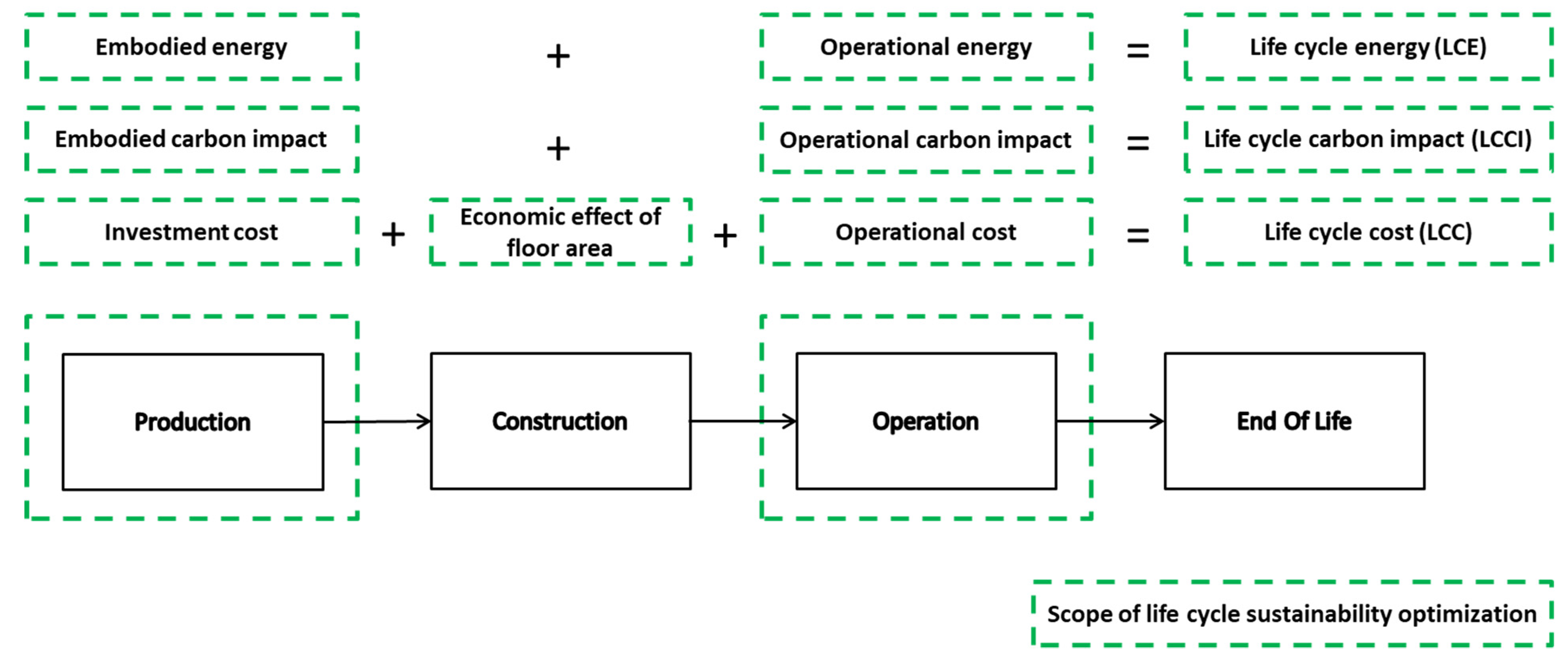
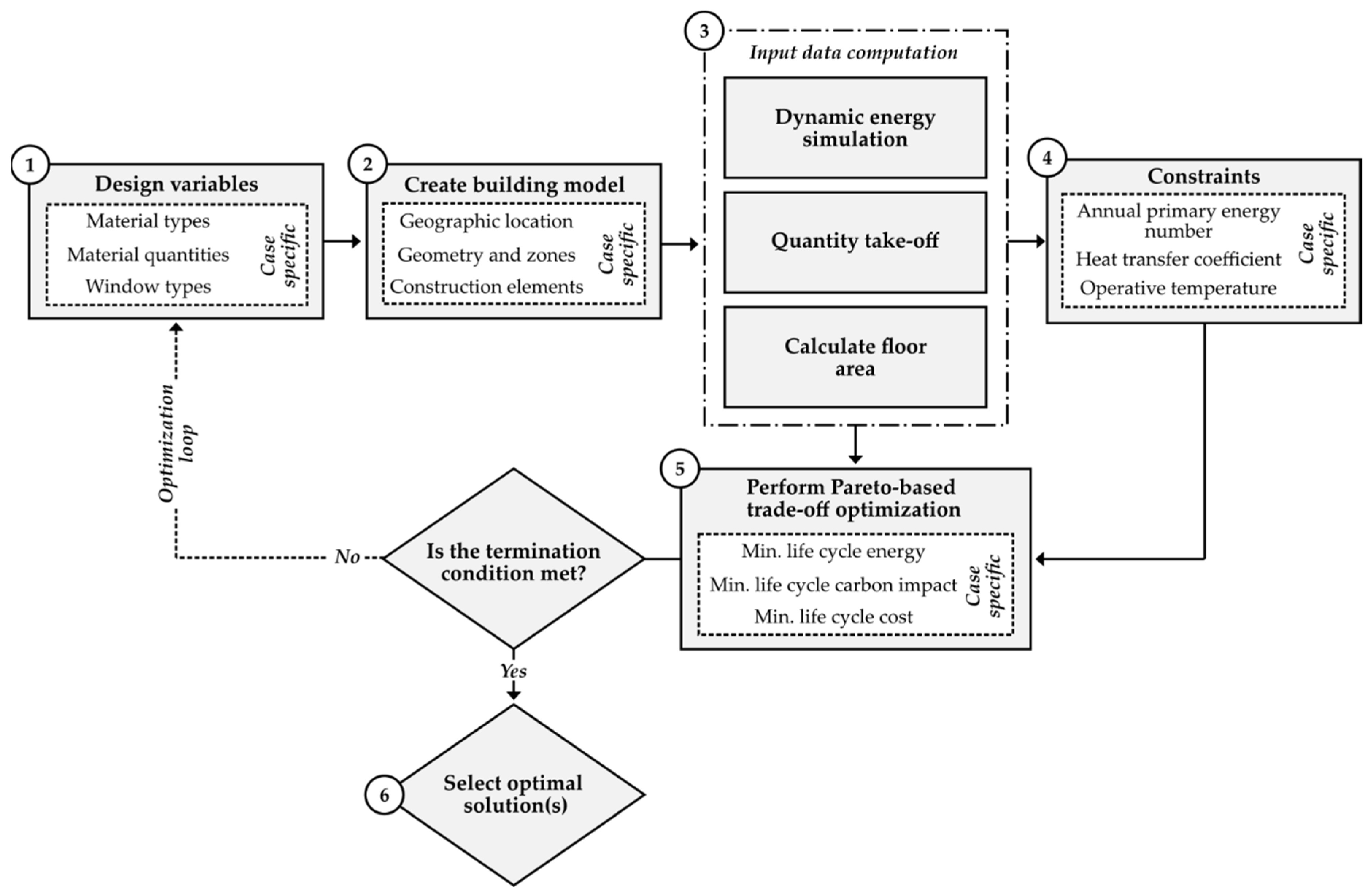
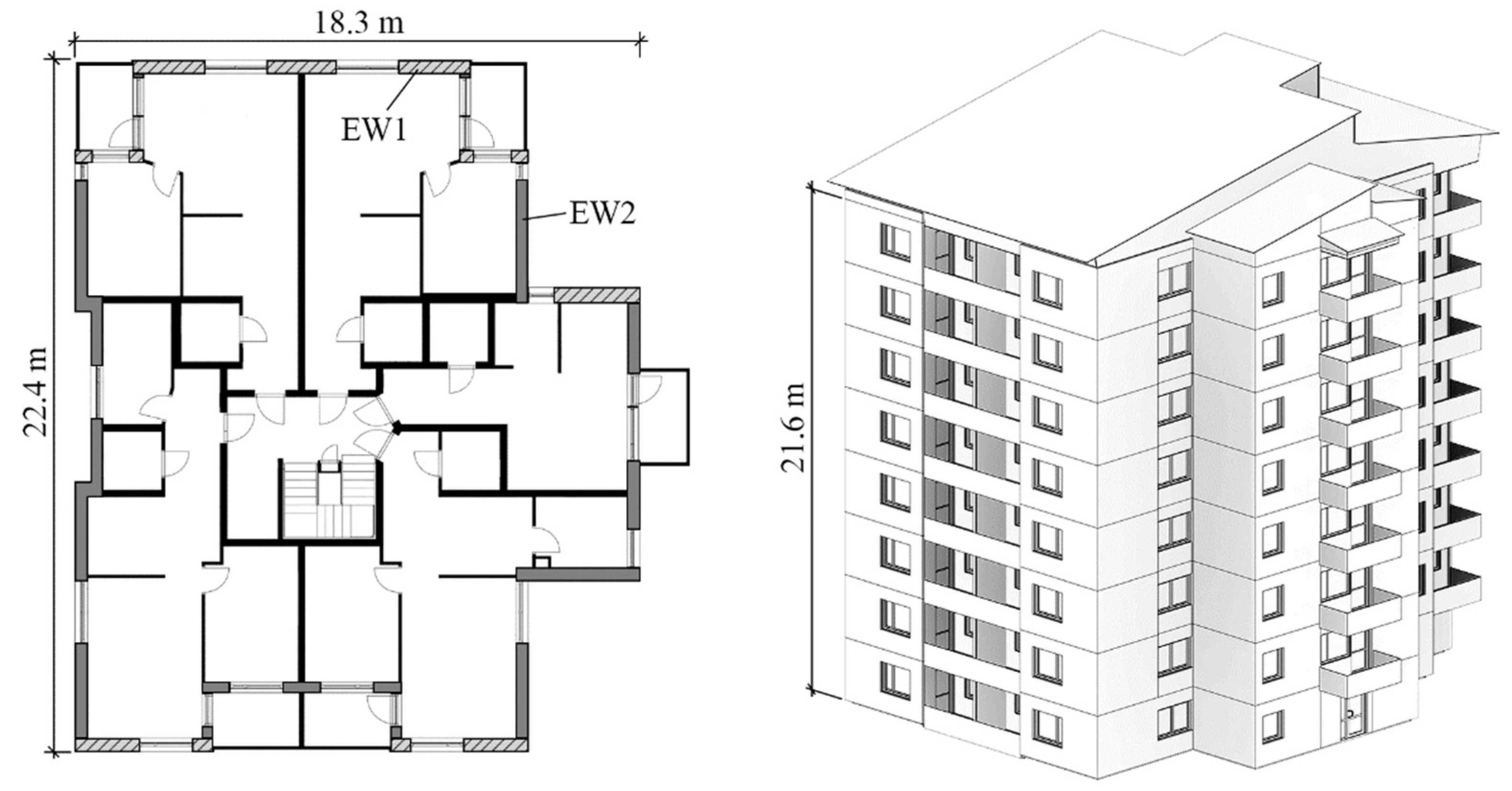
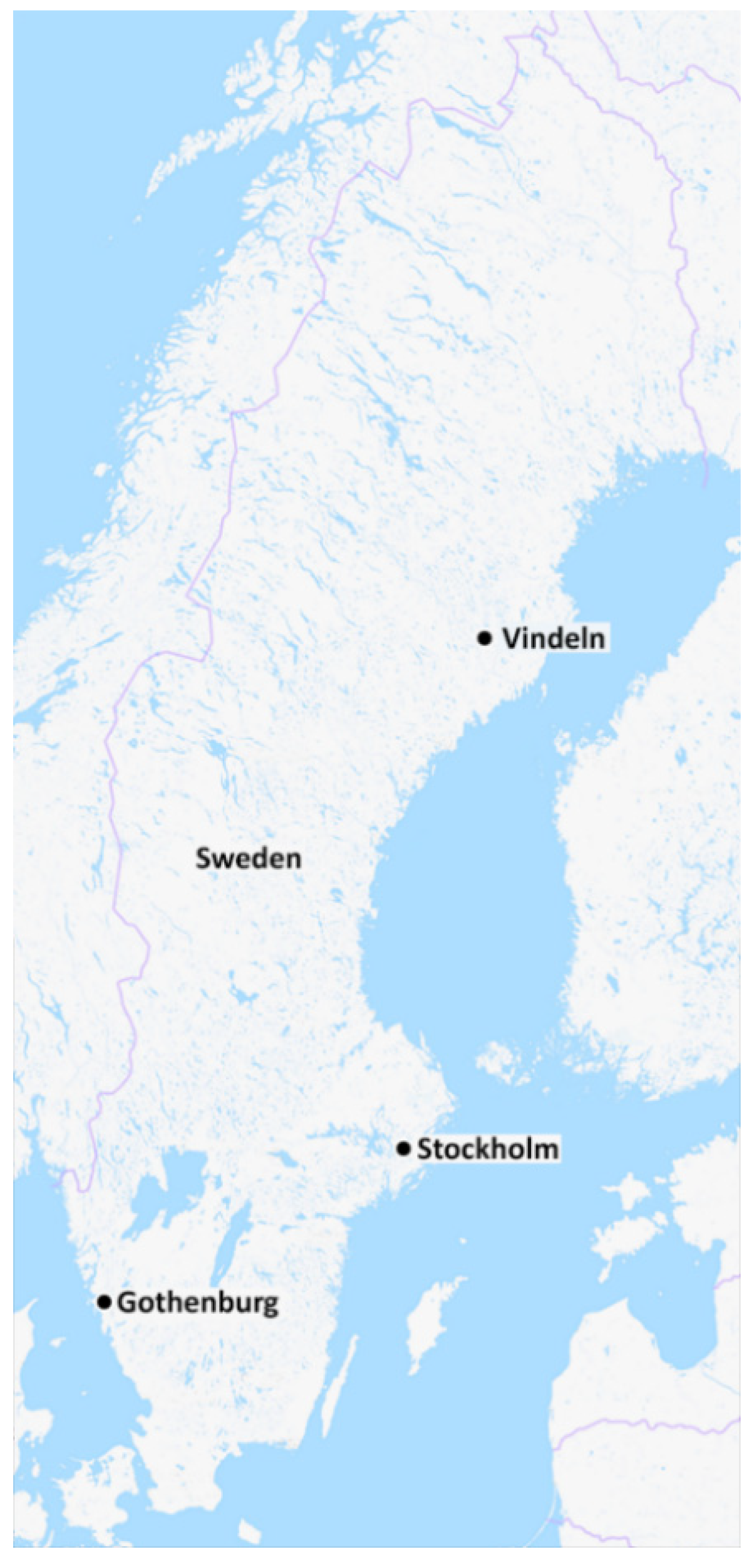
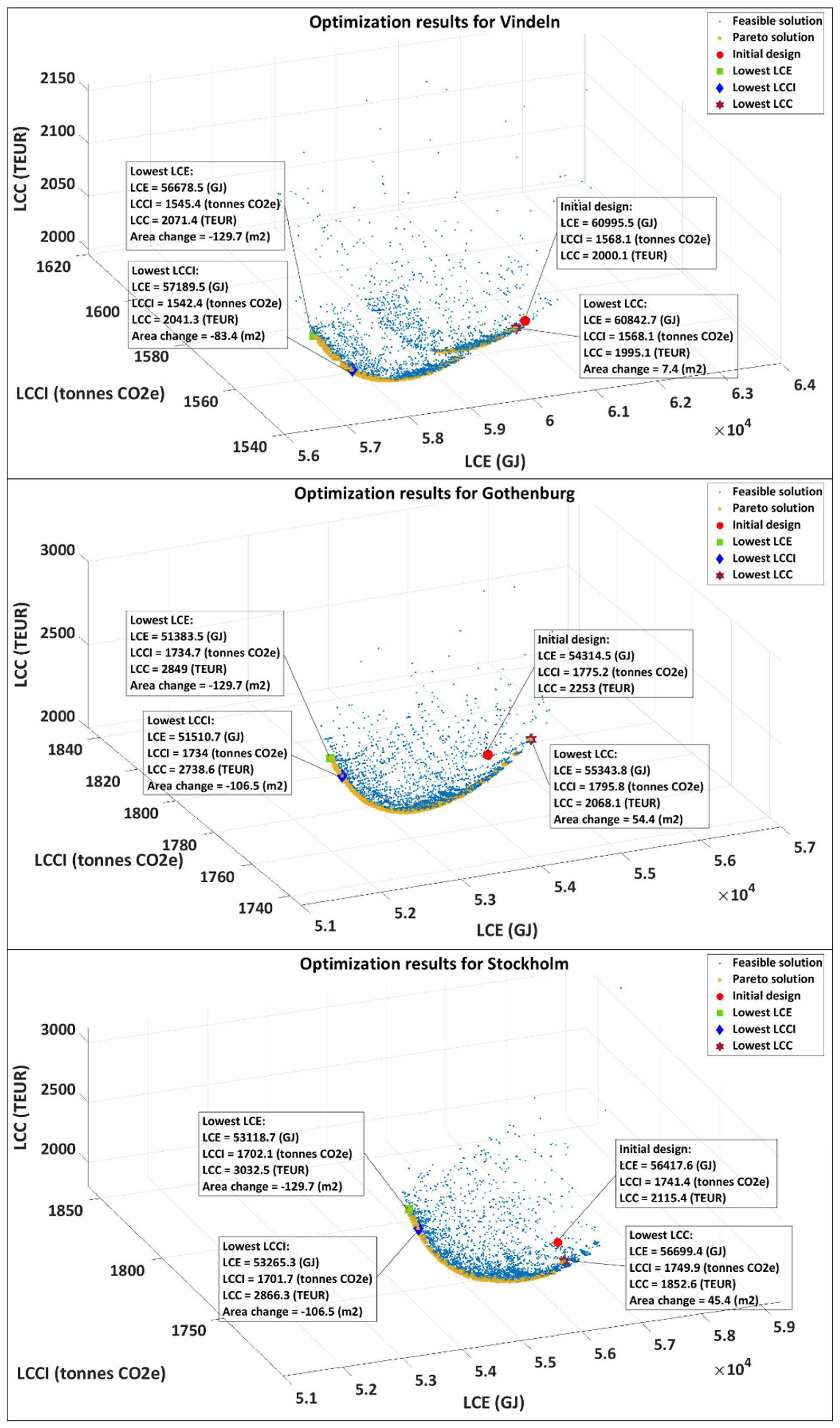
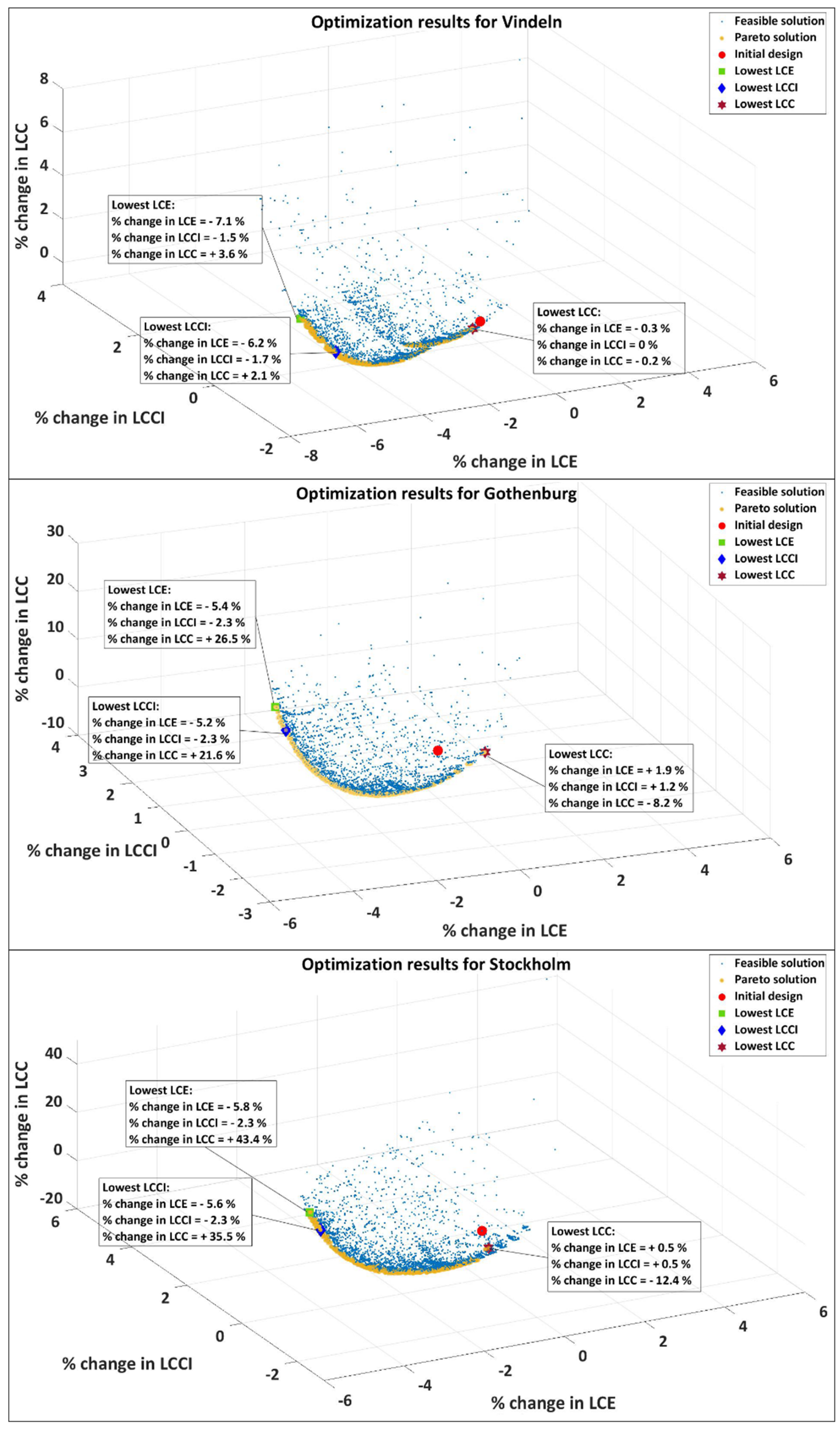
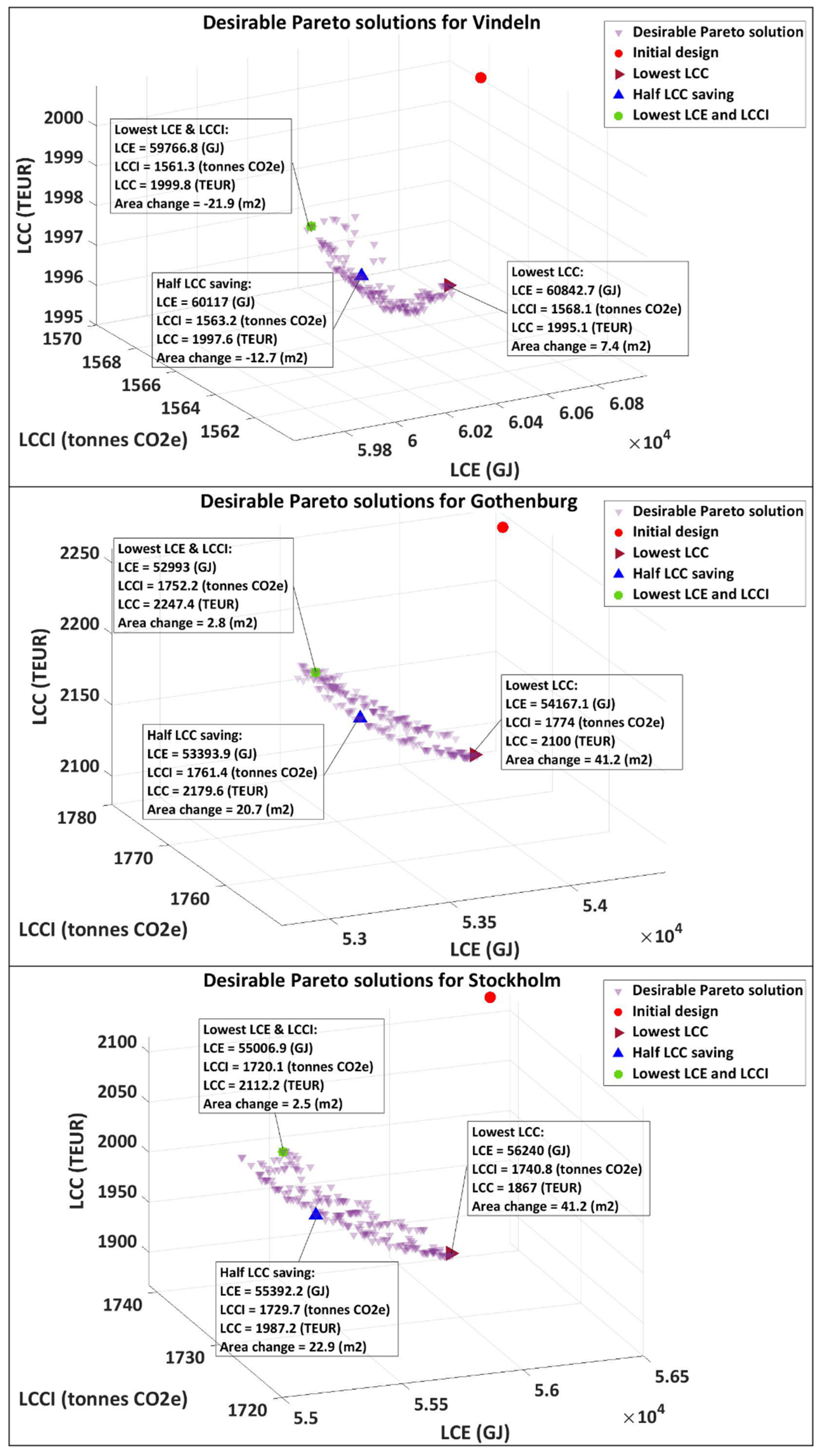

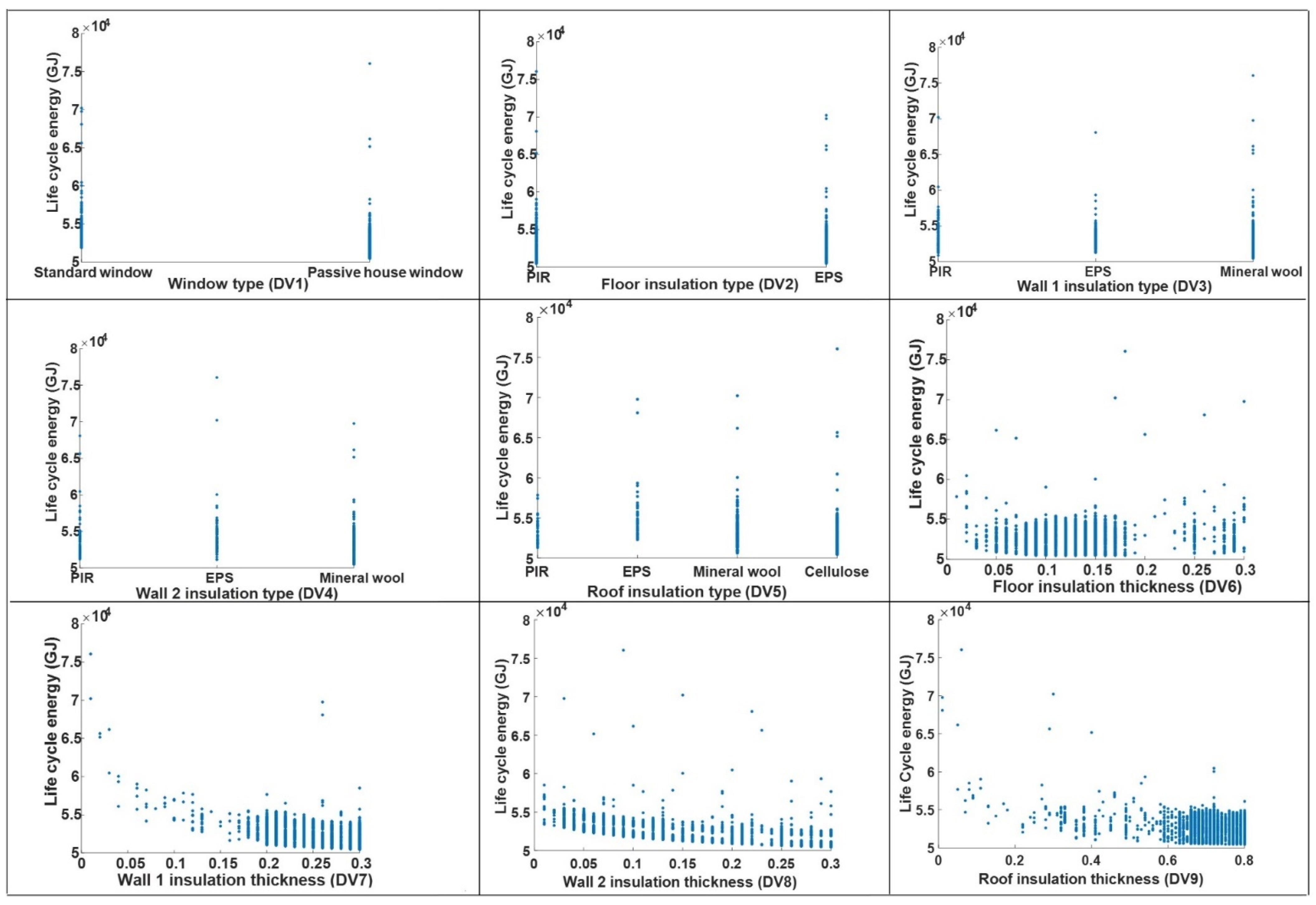
| Component/Construction Element | Enclosed Area (m2) | Initial U-Value (W/m2K) | Initial Type/Initial Material in the Related Construction Element | Initial Thickness (m) | Design Variable Number (Component/Material Type) | Design Variable Number (Material Thickness) |
|---|---|---|---|---|---|---|
| Window and window-doors | 340 | 1 | Standard Triple-glazed | N/A | DV1 | N/A |
| Exterior floor | 340 | 0.21 | Expanded polystyrene (EPS) | 0.1 | DV2 | DV6 |
| Exterior wall (EW) 1 | 502 | 0.178 | Mineral wool (MW) | 0.17 | DV3 | DV7 |
| Exterior wall (EW) 2 | 1068 | 0.15 | Mineral wool | 0.08 | DV4 | DV8 |
| Roof | 340 | 0.11 | Cellulose | 0.45 | DV5 | DV9 |
| Index Number | Component/Material | Functional Unit | Thermal Conductivity (W/m·K) | Embodied Energy (MJ) | Embodied Carbon (kg CO2eq) | Investment Cost (EUR ) |
|---|---|---|---|---|---|---|
| 1 | Standard Triple-glazed window (U = 1 W/m2K) | m2 | N/A | 1462 | 69 | 392.2 |
| 2 | Passive house window (U = 0.8 W/m2K) | m2 | N/A | 1585 | 76.4 | 522.2 |
| 3 | Polyisocyanurate (PIR) insulation | kg | 0.028 | 102.1 | 4.84 | 8.1 |
| 4 | Expanded polystyrene (EPS) insulation | kg | 0.035 | 88.6 | 3.29 | 3.2 |
| 5 | Mineral wool | kg | 0.036 | 16.6 | 1.28 | 1.4 |
| 6 | Cellulose | kg | 0.042 | 2.5 | 0.5 | 1.2 |
| Design Variable Number (Component and Material Types) | Index Min | Index Max |
|---|---|---|
| Window type (DV1) | 1 | 2 |
| Exterior floor insulation (DV2) | 3 | 4 |
| Wall 1 insulation (DV3) | 3 | 5 |
| Wall 2 insulation (DV4) | 3 | 5 |
| Roof insulation (DV5) | 3 | 6 |
| Design Variable Number (Material Thicknesses) | Lower Bound (m) | Upper Bound (m) |
|---|---|---|
| Exterior floor insulation thickness (DV6) | 0 | 0.3 |
| Wall 1 insulation thickness (DV7) | 0 | 0.3 |
| Wall 2 insulation thickness (DV8) | 0 | 0.3 |
| Roof insulation thickness (DV9) | 0 | 0.8 |
| Parameters | Value |
|---|---|
| Building’s lifespan | 50 years |
| Room’s temperature set point (heating) | 21 °C |
| Cooling | N/A |
| Hot water demand | 25 kWh/(m2·yr) |
| Internal gains from domestic hot water usage | 20% |
| Number of occupants | 0.033 occupants/m2 |
| Occupant presence | 14 h/day |
| Effect per occupant | 80 W |
| Internal gains from occupants’ heat | 100% |
| Mechanical ventilation (air flow) | 0.35 l/(s·m2) |
| Infiltration rate (constant) | 0.6 l/(s·m2 surface area) |
| Additional energy use and losses (e.g., distribution system losses, plant losses, and thermal bridges) | 10% of the heating demand |
| Escalation rate of energy price (e) | 3% |
| Real interest rate (r) | 2% * |
| Average real estate value | Vindeln = 710 (EUR/m2) Gothenburg = 4810 (EUR/m2) Stockholm = 7187 (EUR/m2) |
| Location | Window Type (DV1) | Exterior Floor Insulation Type (DV2) | Wall 1 Insulation Type (DV3) | Wall 2 Insulation Type (DV4) | Roof Insulation Type (DV5) | Exterior Floor Insulation Thickness (DV6) (m) | Wall 1 Insulation Thickness (DV7) (m) | Wall 2 Insulation Thickness (DV8) (m) | Roof Insulation Thickness (DV9) (m) | Change in Floor Area (m2) | |||||
|---|---|---|---|---|---|---|---|---|---|---|---|---|---|---|---|
| Min | Max | Min | Max | Min | Max | Min | Max | Min | Max | ||||||
| Vindeln | Standad window | EPS | Mineral wool | Mineral wool | Cellulose | 0.09 | 0.16 | 0.2 | 0.27 | 0.05 | 0.1 | 0.66 | 0.8 | −22.2 | 7.4 |
| Gothenb-urg | Passive house window | EPS | Mineral wool/PIR | Mineral wool/PIR | Cellulose | 0.11 | 0.18 | 0.13 | 0.23 | 0 | 0.07 | 0.67 | 0.8 | 2.8 | 41.2 |
| Stockho-lm | Passive house window | EPS/PIR | Mineral wool/PIR | Mineral wool/PIR | Cellulose | 0.07 | 0.21 | 0.13 | 0.24 | 0 | 0.07 | 0.69 | 0.8 | 2.5 | 41.2 |
| Location | Solution | Window Type (DV1) | Exterior Floor Insulation (DV2) | Wall 1 Insulation (DV3) | Wall 2 Insulation (DV4) | ROOF Insulation (DV5) | Exterior Floor Insulation Thickness (DV6) (M) | Wall 1 Insulation Thickness (DV7) (m) | Wall 2 Insulation Thickness (DV8) (m) | Roof Insulation Thickness (DV9) (m) | Change in Floor Area (m2) | LCE (GJ) | LCCI (Tonnes CO2e) | LCC (TEUR) | LCE Saving Relative to Initial Design (GJ) | LCCI Saving Relative to Initial Design(Tonnes CO2e) | LCC Saving Relative to Initial Design (TEUR) | Corresponds to X Years Primary Energy Use in Initial Design’s Heating Demand | Corresponds to X Years Carbon Footprint in Initial Design’s Heating Demand | Corresponds to X Years Cost of Initial Design’s Heating Demand |
|---|---|---|---|---|---|---|---|---|---|---|---|---|---|---|---|---|---|---|---|---|
| Vindeln | Lowest LCC | Standard window | EPS | Mineral wool | Mineral wool | Cellulose | 0.13 | 0.2 | 0.05 | 0.67 | 7.4 | 60,842.7 | 1568.1 | 1995.1 | 152.8 | 0.3 | 4.9 | 0 | 0 | 1 |
| Half LCC saving | Standard window | EPS | Mineral wool | Mineral wool | Cellulose | 0.14 | 0.25 | 0.07 | 0.68 | −12.7 | 60,117 | 1563.2 | 1997.6 | 878.5 | 5.2 | 2.5 | 3 | 1 | 0 | |
| Lowest LCE and LCCI | Standard window | EPS | Mineral wool | Mineral wool | Cellulose | 0.14 | 0.25 | 0.09 | 0.77 | −21.9 | 59,766.8 | 1561.3 | 1999.8 | 1228.7 | 7.1 | 0.3 | 4 | 2 | 0 | |
| Gothenburg | Lowest LCC | Passive house window | EPS | PIR | NA | Cellulose | 0.15 | 0.13 | NA | 0.7 | 41.2 | 54,167.1 | 1774 | 2100 | 147.4 | 1.2 | 153 | 1 | 0 | 25 |
| Half LCC saving | Passive house window | EPS | PIR | Mineral wool | Cellulose | 0.15 | 0.16 | 0.04 | 0.75 | 20.7 | 53,393.9 | 1761.4 | 2179.6 | 920.6 | 13.8 | 73.4 | 4 | 3 | 13 | |
| Lowest LCE and LCCI | Passive house window | EPS | Mineral wool | Mineral wool | Cellulose | 0.13 | 0.2 | 0.06 | 0.8 | 2.8 | 52,993 | 1752.2 | 2247.4 | 1321.5 | 23 | 5.6 | 6 | 5 | 1 | |
| Stockholm | Lowest LCC | Passive house window | EPS | PIR | NA | Cellulose | 0.15 | 0.13 | NA | 0.7 | 41.2 | 56,240 | 1740.8 | 1867 | 177.6 | 0.5 | 248.4 | 1 | 0 | 40 |
| Half LCC saving | Passive house window | EPS | PIR | PIR | Cellulose | 0.12 | 0.15 | 0.04 | 0.8 | 22.9 | 55,392.2 | 1729.7 | 1987.2 | 1025.4 | 11.7 | 128.2 | 4 | 2 | 23 | |
| Lowest LCE and LCCI | Passive house window | EPS | Mineral wool | Mineral wool | Cellulose | 0.12 | 0.18 | 0.07 | 0.8 | 2.5 | 55,006.9 | 1720.1 | 2112.2 | 1410.7 | 21.3 | 3.2 | 5 | 5 | 1 |
Publisher’s Note: MDPI stays neutral with regard to jurisdictional claims in published maps and institutional affiliations. |
© 2022 by the authors. Licensee MDPI, Basel, Switzerland. This article is an open access article distributed under the terms and conditions of the Creative Commons Attribution (CC BY) license (https://creativecommons.org/licenses/by/4.0/).
Share and Cite
Shadram, F.; Mukkavaara, J. Improving Life Cycle Sustainability and Profitability of Buildings through Optimization: A Case Study. Buildings 2022, 12, 497. https://doi.org/10.3390/buildings12040497
Shadram F, Mukkavaara J. Improving Life Cycle Sustainability and Profitability of Buildings through Optimization: A Case Study. Buildings. 2022; 12(4):497. https://doi.org/10.3390/buildings12040497
Chicago/Turabian StyleShadram, Farshid, and Jani Mukkavaara. 2022. "Improving Life Cycle Sustainability and Profitability of Buildings through Optimization: A Case Study" Buildings 12, no. 4: 497. https://doi.org/10.3390/buildings12040497
APA StyleShadram, F., & Mukkavaara, J. (2022). Improving Life Cycle Sustainability and Profitability of Buildings through Optimization: A Case Study. Buildings, 12(4), 497. https://doi.org/10.3390/buildings12040497






